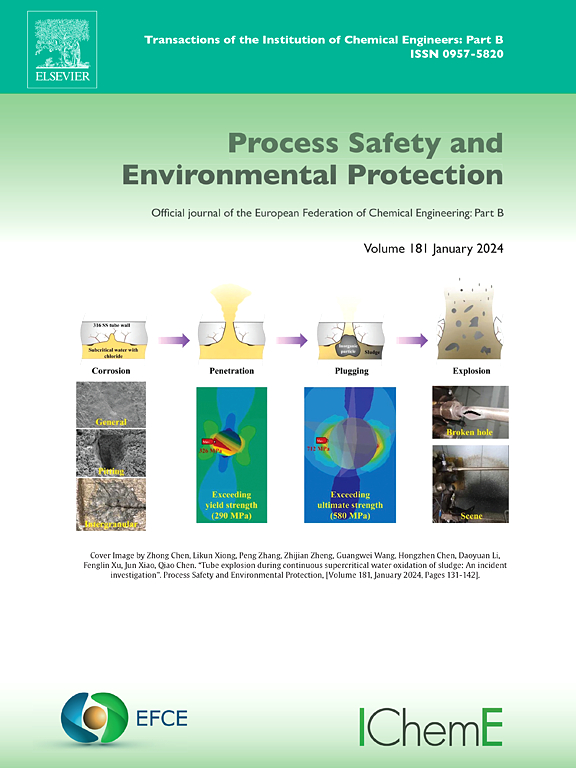温度、H2O和NO2对CO2输送管道腐蚀的影响
IF 6.9
2区 环境科学与生态学
Q1 ENGINEERING, CHEMICAL
引用次数: 0
摘要
碳捕集、利用和封存(CCUS)的扩张凸显了对二氧化碳(CO2)管道运输日益增长的需求。虽然纯CO2无腐蚀性,但H2O和NO2等杂质会产生腐蚀性环境,危及管道的完整性。本研究考察了在CO2管道条件下,H2O和NO2浓度以及温度对腐蚀的影响。实验在100 巴、5 °C和25 °C的温度下模拟0.96 m/s的线速度的高压釜中进行,测试了X52和GR70以及一种更耐腐蚀的9Cr合金。结果表明,与不含NO2的情况相比,NO2的存在提高了腐蚀速率。低水浓度导致在5 °C下的腐蚀速率比在25 °C下的腐蚀速率高5倍。在两种温度下,无NO2和70 ppmv H2O的碳钢均观察到低至中度腐蚀。在SO2和O2存在的情况下,将H2O浓度降低到70 ppmv以下并去除NO2,只会导致碳钢CO2管道的低至中度腐蚀。在5 °C时,X52和GR70的腐蚀速率分别是25 °C时的5倍和3倍,分别是0.065 mm/y和0.016 mm/y。研究认为,H2O应保持在70 ppmv以下,NO2应消除,以防止严重腐蚀。强调符合二氧化碳规范的重要性,以及进一步研究符合规范的二氧化碳成分的必要性。本文章由计算机程序翻译,如有差异,请以英文原文为准。
The influence of temperature, H2O, and NO2 on corrosion in CO2 transportation pipelines
The expansion of Carbon Capture, Utilization, and Storage (CCUS) highlights the growing need for carbon dioxide (CO2) pipeline transportation. While pure CO2 is non-corrosive, impurities such as H2O and NO2 create a corrosive environment that risks pipeline integrity. This study investigates how H2O and NO2 concentrations, along with temperature, influence corrosion under CO2 pipeline conditions. The investigation was performed in an autoclave setup emulating a linear velocity of 0.96 m/s at 100 bar and temperatures of 5 ∘C and 25 ∘C, testing X52 and GR70, and a more corrosion-resistant 9Cr alloy. The results indicated that the presence of NO2 elevated the corrosion rate compared to scenarios without. Low H2O concentration led to a corrosion rate of up to five times higher at 5 ∘C, compared to at 25 ∘C, in the presence of NO2. Low to moderate corrosion was observed for the carbon steels without NO2 and with 70 ppmv H2O at both temperatures. Reducing the H2O concentration below 70 ppmv and removing NO2, while SO2 and O2 are present, will only result in low to moderate corrosion in the carbon steel CO2 pipeline. The corrosion rate for X52 and GR70 was 0.065 mm/y and 0.016 mm/y higher or 5 and 3 times greater, respectively, at 5 ∘C compared to 25 ∘C. The study concludes that H2O should be maintained below 70 ppmv and NO2 should be eliminated to prevent severe corrosion. Emphasizing the importance of CO2 specification compliance and the need for further research into CO2 compositions that align with the specifications.
求助全文
通过发布文献求助,成功后即可免费获取论文全文。
去求助
来源期刊

Process Safety and Environmental Protection
环境科学-工程:化工
CiteScore
11.40
自引率
15.40%
发文量
929
审稿时长
8.0 months
期刊介绍:
The Process Safety and Environmental Protection (PSEP) journal is a leading international publication that focuses on the publication of high-quality, original research papers in the field of engineering, specifically those related to the safety of industrial processes and environmental protection. The journal encourages submissions that present new developments in safety and environmental aspects, particularly those that show how research findings can be applied in process engineering design and practice.
PSEP is particularly interested in research that brings fresh perspectives to established engineering principles, identifies unsolved problems, or suggests directions for future research. The journal also values contributions that push the boundaries of traditional engineering and welcomes multidisciplinary papers.
PSEP's articles are abstracted and indexed by a range of databases and services, which helps to ensure that the journal's research is accessible and recognized in the academic and professional communities. These databases include ANTE, Chemical Abstracts, Chemical Hazards in Industry, Current Contents, Elsevier Engineering Information database, Pascal Francis, Web of Science, Scopus, Engineering Information Database EnCompass LIT (Elsevier), and INSPEC. This wide coverage facilitates the dissemination of the journal's content to a global audience interested in process safety and environmental engineering.
 求助内容:
求助内容: 应助结果提醒方式:
应助结果提醒方式:


